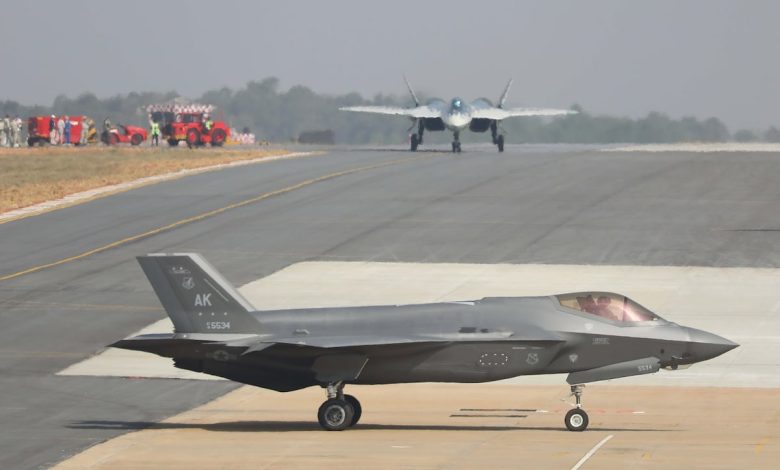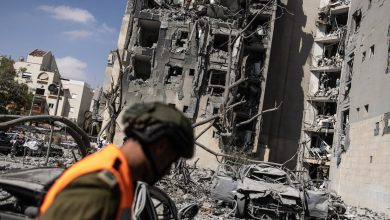For India, it’s ‘Pick your fighter,’ as Delhi weighs US, Russian bids

BENGALURU, India — The cream of the U.S. and Russian air forces shared a runway at the recent Aero India 2025 exhibition in Bengaluru, as both the Lockheed Martin F-35A and Sukhoi Su-57E attempted to woo the Indian Air Force towards an unlikely deal.
Emanating from opposing blocs, the surprising juxtaposition of these latest fifth-generation fighters at Aero India, held here Feb. 10-14, illustrates India’s non-aligned stance. Historically, Delhi has relied on Russia for military equipment, though the U.S. has made significant inroads into the market in recent years.
The latest competitive jostling surrounds fifth-generation fighters. A Rosoboronexport official said India could manufacture the Su-57 at home with full technology transfer. Russia’s defense export agency said it has held informal talks with Hindustan Aeronautics Limited (HAL) on the subject, and believes the Su-57 could be built at HAL’s Nasik facility where Su-30MKI jets are currently assembled.
Ironically, India had previously pulled out of an Indo-Russian collaborative project that ultimately resulted in the Su-57.
The Russian Air Force received its first Su-57 in 2020. Alexander Mikheev, director general of Rosoboronexport, declared at the air show here: “The first foreign customer of the promising, multifunctional, fifth-generation fighter Su-57E in 2025 will begin operating this aircraft which will be delivered by Rosoboronexport.”
A few days later, Algerian media reported that their country is, in fact, the Su-57E’s first export customer.
Thickening the plot, when Indian Prime Minister Narendra Modi met U.S. President Donald Trump at the White House in mid-February, Trump promised he was “paving the way to ultimately provide India F-35 stealth fighters.”
A joint leaders’ statement issued Feb. 13 said the U.S. was reviewing “its policy on releasing fifth-generation fighters” to India. Trump’s vow to put the technologically sensitive F-35 on the table is unprecedented, especially given India’s close relationship with Russia.
Lockheed Martin immediately responded: “We’re encouraged by the recent announcement by President Trump to provide the F-35 to India. We look forward to working closely with both governments on upcoming strategic procurements, including the fighters.”
Trump’s dangling offer of the F-35 took Delhi by surprise.
“I don’t think, with regard to the acquisition of an advanced aviation platform by India, that process has started as yet,” an Indian Ministry of External Affairs spokesperson said. “So this is currently something that’s at the stage of a proposal.”
India has an airpower gap with nemesis China, but it is unclear whether the F-35 is the right solution.
Apart from the U.S. being paranoid about F-35 technologies falling into the wrong hands, how would the advanced fighter integrate into India’s existing command-and-control networks?
The F-35 will unlikely be permitted to plug into networks containing India’s backbone of Russian-designed Su-30MKI fighters, for example.
The unexpected Russian Su-57E and American F-35 offers also come amidst Modi’s efforts to boost defense equipment self-reliance. In fact, India is presently pursuing its own indigenous, fifth-generation Advanced Medium Combat Aircraft (AMCA) program.
The government displayed a full-scale model of the AMCA for the first time at Aero India 2025. The project promises, optimistically, first fighter deliveries in 2034. However, buying either the F-35 or Su-57 runs the risk of asphyxiating India’s AMCA effort.
India has signed $50 billion in defense contracts with Russia over the past 20 years. The Stockholm International Peace Research Institute reported that 36% of Indian defense imports came from Russia over 2019-2023. However, this represented a 34% drop compared to the preceding 2014-2018 timeframe.
As the world’s largest weapon importer from 2008-2023, India accounted for 10% of global arms imports. In that same period, according to a recent U.S. Congressional Research Service report, 62% of Delhi’s military imports came from Russia, 11% from France, 10% from the U.S. and 7% from Israel.
The same report remarked, “The U.S. government is actively encouraging India to reduce its dependence on Russian-origin defense articles.”
India is too important a market for the U.S. to ignore. Prior to 2008, American sales of defense articles to Delhi were virtually nonexistent, but since then it has accrued more than US$20 billion in sales.
Important American exports include C-130J Super Hercules, C-17A Globemaster IIIs, P-8I aircraft, CH-47F Chinooks, MH-60Rs, AH-64E Apaches, Hellfire and Stinger missiles, M777A2 howitzers, SIG Sauer SIG716 assault rifles and Harpoon anti-ship missiles.
India’s latest American deal, worth a mammoth $4 billion, is for 31 MQ-9B drones.
The Trump-Modi statement noted a “deepening convergence of U.S.-India strategic interests.” To further advance defense ties, the two will sign a new ten-year framework for a major defense partnership later this year.
The statement also announced plans to “pursue this year new procurements and co-production arrangements” for Javelin missiles, Stryker 8×8 vehicles and six additional P-8I maritime patrol aircraft “following agreement on sale terms.”
Earlier this month, India declared a 9.53% hike to $78.3 billion in its 2025-2026 defense budget.
“In the current geopolitical scenario where the world is witnessing a changing paradigm of modern warfare, the Indian Armed Forces need to be equipped with state-of-the-art weapons and have to be transformed into a technologically advanced combat-ready force,” reads a Ministry of Defence statement.
Delhi now has a choice – to renew reliance on Russia by buying the Su-57E; continue switching allegiance to the U.S. with an F-35 order; or spurn both by putting all its eggs in the AMCA basket and accepting a prolonged capability gap vis-à-vis China in the near term.
Gordon Arthur is an Asia correspondent for Defense News. After a 20-year stint working in Hong Kong, he now resides in New Zealand. He has attended military exercises and defense exhibitions in about 20 countries around the Asia-Pacific region.







